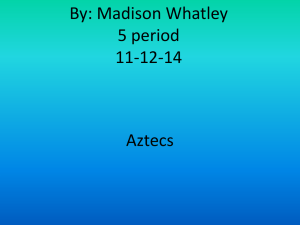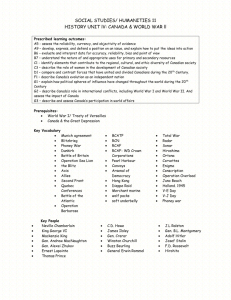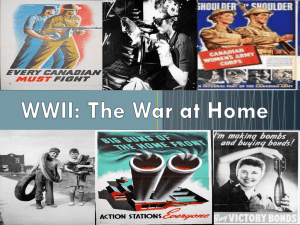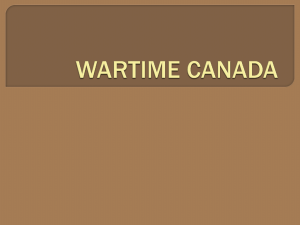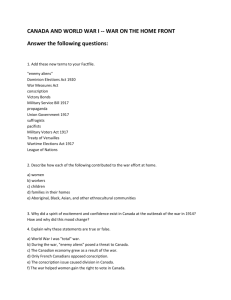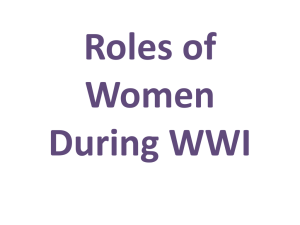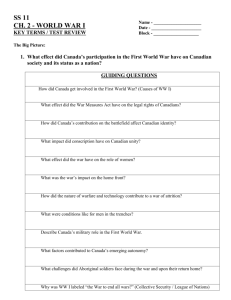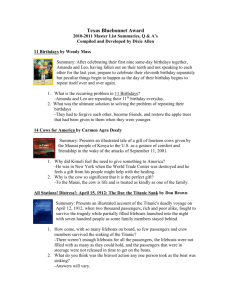It is seen as a “turning point” because
advertisement
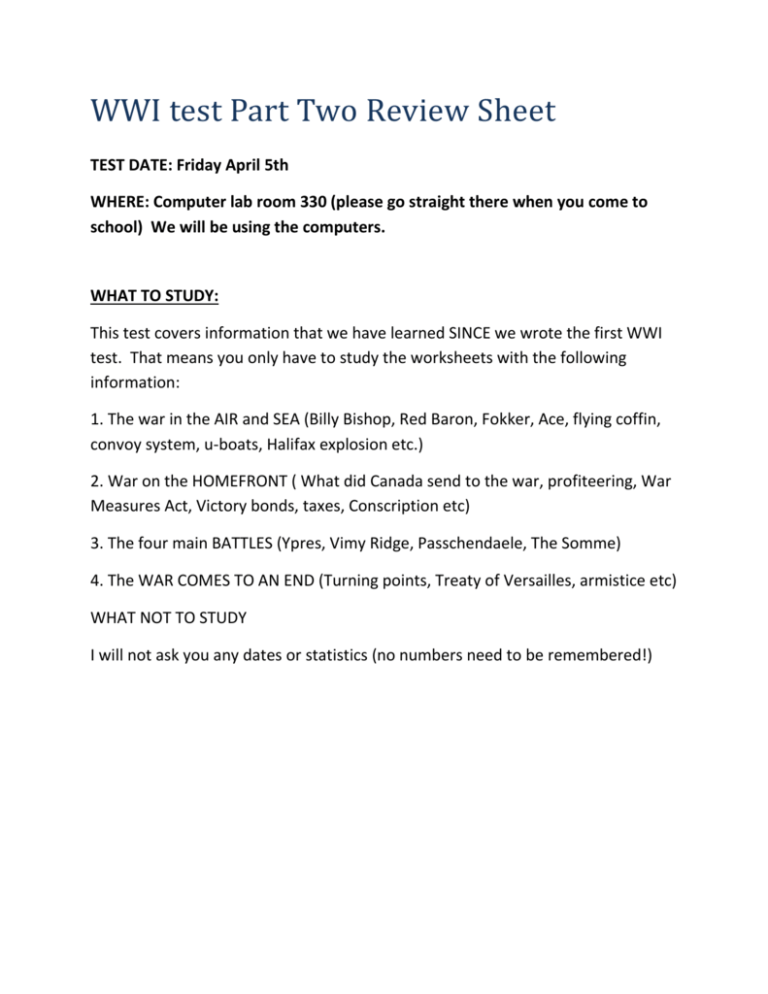
WWI test Part Two Review Sheet TEST DATE: Friday April 5th WHERE: Computer lab room 330 (please go straight there when you come to school) We will be using the computers. WHAT TO STUDY: This test covers information that we have learned SINCE we wrote the first WWI test. That means you only have to study the worksheets with the following information: 1. The war in the AIR and SEA (Billy Bishop, Red Baron, Fokker, Ace, flying coffin, convoy system, u-boats, Halifax explosion etc.) 2. War on the HOMEFRONT ( What did Canada send to the war, profiteering, War Measures Act, Victory bonds, taxes, Conscription etc) 3. The four main BATTLES (Ypres, Vimy Ridge, Passchendaele, The Somme) 4. The WAR COMES TO AN END (Turning points, Treaty of Versailles, armistice etc) WHAT NOT TO STUDY I will not ask you any dates or statistics (no numbers need to be remembered!) THE WAR IN THE AIR Read pages 30-33 Definitions: Silver Dart: An airplane designed by McCurdy and Bell. It's the first airplane Canada ever put in the air in 1909 in Nova Scotia. Royal Flying Corps: The name of the British air force. Today it is called the Royal Canadian Air Force (RCAF). Canada did not have its own air force at the beginning of the war Dogfight: Air battles between fighter planes in WW1 Flying Coffins: The lifespan for pilots was only three weeks,so they called their planes 'coffins'. They were not allowed to carry parachutes, since the air force cared more about the planes than the pilots. Nowadays, pilots carry parachutes. Air Ace: A pilot has to shoot down 5 enemy planes to be called this. Red Baron: He was a German pilot who shot down 80 aircraft. He flew a red plane, giving him the name 'Red Baron'. After reading the section called “Technical Edge” explains how planes where used in this war. Aircraft design had not advanced very during WW1, they had open, single-seat cockpits, they often used view enemy activity from above. Most of them flew at 150 km/h and did not have weapons . Then they started to have guns. Machine guns started to be placed in front of the propeller, for instance, the Fokker (a German plane) had a mechanized machine gun. By the end of the war, there were different types of aircraft, such as blimps and bombers. Billy Bishop (read page 32) Write a summary for Canada’s most famous fighter pilot. -He was born in Owen Sound -He died in 1956 -He was Canada's greatest hero -No. 1 pilot in Canada -He earned the Victoria Cross,the highest medal for bravery -He was hyperactive -He did not do well at school -He was an excellent marksman -He at first rode a horse when he entered the war, he hated it, and he didn't get to be a pilot. - He was a rebel -In one month, he shot down 17 planes -He dueled the Red Baron, they destroyed each other's planes -He went on a solo mission -He was recalled to Canada and went on a tour across the country, getting people to buy victory bonds -He helped train pilots for WW2 Billy Bishop Paragraph Billy Bishop was born in Owen Sound in 1894. As a child he did not enjoy going to school but would rather spend his time outside practicing hunting and marksmanship. He joined the British air force and in his first month he shot down 17 enemy aircraft. Billy was known as the greatest ace in the British Empire having shot down a total of 72 enemy aircraft. He won the Victoria Cross for bravery. Before retiring, he did help train pilots for the Second World War. War At Sea -Ships were used to transport soldiers and supplies for the war. -Convoys, which are groups of ships that traveled together, left Halifax harbor to bring supplies to Europe. -Halifax Explosion was the result of two ships colliding in the harbor. -German U-Boats were lurking in the Atlantic ocean, hoping to destroy merchant ships. -The Lusitania cruise ship, was carrying Americans and a German U-Boat sunk it. -This caused the US to declare war on Germany(1917). PART TWO: WAR ON THE HOMEFRONT Read pages 42-44 1. Why was it up to Canadian farmers to supply food to Europe? It was up to Canadian farmers to supply food to Europe because most European farmers were already involved with the war. 2. Name some of the food that was sent overseas by Canada. Some of the food that was sent overseas by Canada was beef, cheese, pork, and wheat/bread. 3. Define armaments. Armaments- weaponry used in warfare. 4. What types of armaments were manufactured in Canada? What types of raw materials were sent to Europe to help in the war? Other than what was mentioned above, what else did Canadian factories produce for the war effort? Airplane parts, submarine parts/ torpedoes, guns, shells (bullets), ships. Raw materials- aluminum, steel, nickel, timber(wood), railway tracks. What else did factories produce- medical kits, uniform, other equipment? 5. What is profiteering? Provide an example of profiteering in this war. Take advantage of situation e.g. during war gun makers or uniform makers would use low quality products and sell them as if they were high quality products, to make more money faster. 6. What is the War Measures Act and why did the Canadian government pass it? The law that gives the Canadian government permission to arrest anyone who they deemed suspicious (mostly went after foreigners) They made this law to protect Canadian citizens from spies. 7. What group of recent immigrants living in Canada was most affected by the passing of the War Measures Act? Why were they considered “suspicious”? The Ukrainian immigrants were most affected by the passing of the War Measures Act? They considered the Ukrainians “suspicious” because they were controlled by the Austrians who were allied with the German. 8. Explain how a Victory Bond worked. Why did the Government of Canada need to sell these Bonds to Canadians? A Victory bond is way for the government to ask Canadians to donate their money to the government then if things go well they will get their money back and some extra money 9. What else did the Canadian Government do to raise money for the war? The Canadian Government did many things to raise money for the war such as introducing taxes, income tax (certain amount of money taken from your pay cheque ) and also corporate tax wich means the government takes money from every business owners profits. 10. In your opinion, what do you think the Canadian government needed all of this money for? What is so expensive about war? They needed money to produce items and transport them too. Things get warn out so people are constantly making more and more of supply WARTIME ISSUES Use Complete sentences to answer the following questions. Read pages 46-49 1. Who was Canada’s Prime Minister during the war? What problem did he face in 1917? Prime Minister Borden faced a large problem because he promised not to introduce conscription but later he had to break the promise and introduce conscription to Canadians. He had faced problems from French Canadians and from western settlers. 2. What does conscription mean? Why did Canada have to turn to Conscription to help fight WWI? Conscription means that the government can force you to go to war no longer you only can get in by volunteering yourself. Canada had to turn to conscription because the amount of people who die on a day to day basest is much larger than the amount of men who are enrolling. 3. Now look at the chart on page 47. What is the point of the information presented in this chart? The point of the information on the chart in page number 47 is to show how many more men were dying then were enlisting. IMPORTANT BATTLES War Comes to an End Read “The Turning Point in WWI” page 50-51 1917 can be seen as a turning point in WWI. By this time in the war, it was still unsure who would win. Would it be the Triple Entente or the Triple Alliance? It was a STALEMATE. Below, summarize the TWO events that are seen as turning points in this war: 1. The first major turning point in 1917 was: Russia left the war after revolution. They signed a peace treaty with Germany. It is seen as a “turning point” because: Russia had a massive army that could help the Allies win the war. But now, Germany and Austria-Hungary can send all their troops to the Western Front. 2. The second major turning point in 1917 was: The United States of America entered the war due to unrestricted submarine warfare (submarines attacking civilian ships going on vacation, even if they’re American). It is seen as a “turning point” because: The Americans had fresh troops that could arrive on the Western Front to help the British, French, and Canadians (Triple Entente) Germany’s Last Offensive Explain why Germany was forced to surrender and negotiate a Peace Treaty. The people of Germany revolted against the Government because of food shortages and they were sick and tired of the war. Define the term ARMISTICE. When was the armistice signed? Armistice – Another way of saying Peace Treaty or Truce. This was signed on November 11th at 11 o’clock in 1918 Facts and Figures: 9 million soldiers Dead 20 million injured November 11th is now known as Remembrance Day all over Canada THE TREATY OF VERSAILLES The Purpose of the Treaty was to end the war and come up with some rules such as: - What happens to countries that have been invaded? - How do we repair damages and who’s going to pay for them Terms that would have angered Germany: - Paying for damages in the war - Taking full responsibility for the war (the War Guilt Clause) - Losing land - Losing their large military (no u-boats, no airplanes allowed)
